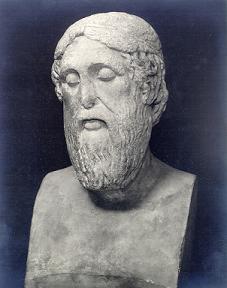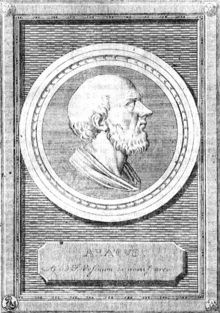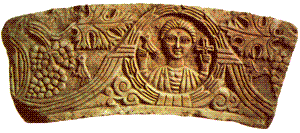The Dionysian Mysteries
Dionysus and Orpheus 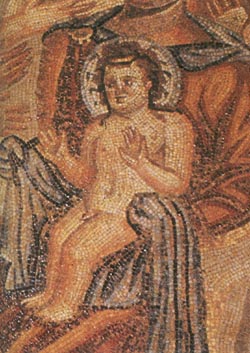 Mosaic from “The House of Dionysus” in Paphos, Cyprus, dated 300s A.D. A halo of light surrounds Dionysus’ head similar to popular Christian iconography 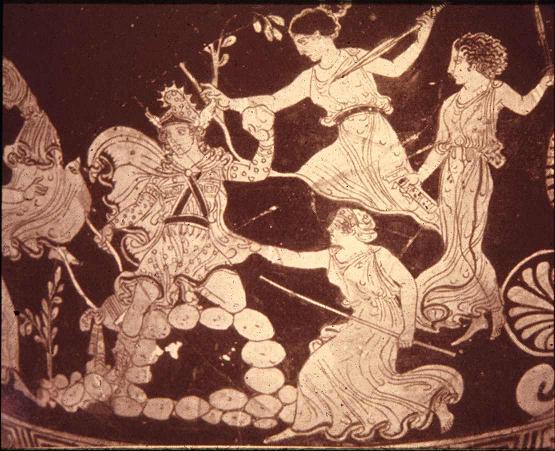 Death of Orpheus on Greek vase An alternate ending to the death of Orpheus includes a version in which the two goddesses Aphrodite and Persephone argue over who would have Adonis, a young god-man representing the sun. Orpheus’ mother Calliope was made judge over the matter by Zeus and so she decreed they would both have him at different times: Aphrodite, the goddess of love and fertility, would have him during Spring and Summer, and Persephone, the Queen of the Dead, would have him in the nether world during Fall and Winter. Angry at the Muses’ judgment, Aphrodite causes the Maenads to lust after Orpheus so violently that they rip him apart, each of them wanting him for her own. Another version has Orpheus killed by a thunderbolt for revealing secret sayings to men outside the cult; another says he committed suicide in grief over his wife. In The Republic, Plato speaks of a soul seeing Orpheus choosing to be reincarnated as a swan “out of enmity to the race of women, hating to be born of a woman because they had been his murderers.” Although it is still debated when the Orphic mysteries were first started, their practices were attested to by the Greek Herodotus in the 420s B.C. The oldest book ever found in Europe, the Derveni papyrus, is itself an Orphic poem produced in the circles of Anaxagoras, who, as mentioned before, taught that the planets were moving bodies rather than gods. The papyrus dates to around 340 B.C., the time of Alexander the Great, and contains a genealogy of the Greek gods not unlike that found in Herodotus. The “Orphic way of life” was one of asceticism similar to that of the Pythagoreans, which included: abstaining from sex, meat, eggs, and beans. It has been argued that the prohibition against beans, however, is symbolic for using “counting beans” in elections, which would hypothetically mean it was a prohibition against becoming involved in politics. Like Plato and Paul, the Orphics believed that the soul was imprisoned in the world of the flesh as punishment and that the body was a kind of “jailhouse.” By following these prohibitions, and possibly other initiatory rites, Orphics believed they could escape continuous reincarnation and commune with the gods. Those who fell away into greater depravity would meet with divine punishment in the afterlife. Also like the monotheistic religions and unlike the pagan religions, the Orphics took their authority from sacred writings, believed to have been written by Orpheus or his disciple, Musaeus. Even though most scholars believe that the majority of Plato’s ideas about the afterlife originated from the Orphic cults, Plato himself does not portray them in a very favorable light. In The Republic, he describes them as vagrant beggar-priests who went door to door among the rich, offering purifications for the atonement of sins: “And they produce a host of books written by Musaeus and Orpheus, who were children of the Moon and the Muses --that is what they say --according to which they perform their ritual, and persuade not only individuals, but whole cities, that expiations and atonements for sin may be made by sacrifices and amusements which fill a vacant hour, and are equally at the service of the living and the dead; the latter sort they call mysteries, and they redeem us from the pains of hell, but if we neglect them no one knows what awaits us.” -Plato, The Republic, Book II Plato disapproved of the idea that people could pray or go through some kind of ritual in order to make up for some injustice, and argued that if that were the case it would be better off to just go on performing injustices and simply make up for it with prayer and proselytizing: “Nevertheless, the argument indicates this, if we would be happy, to be the path along which we should proceed. With a view to concealment we will establish secret brotherhoods and political clubs. And there are professors of rhetoric who teach the art of persuading courts and assemblies; and so, partly by persuasion and partly by force, I shall make unlawful gains and not be punished. Still I hear a voice saying that the gods cannot be deceived, neither can they be compelled. But what if there are no gods? or, suppose them to have no care of human things --why in either case should we mind about concealment? And even if there are gods, and they do care about us, yet we know of them only from tradition and the genealogies of the poets; and these are the very persons who say that they may be influenced and turned by ‘sacrifices and soothing entreaties and by offerings.’ Let us be consistent then, and believe both or neither. If the poets speak truly, why then we had better be unjust, and offer of the fruits of injustice; for if we are just, although we may escape the vengeance of heaven, we shall lose the gains of injustice; but, if we are unjust, we shall keep the gains, and by our sinning and praying, and praying and sinning, the gods will be propitiated, and we shall not be punished.” -Plato, The Republic, Book II Although some legends say Orpheus introduced the cult of Dionysus to Thrace, other sources say that he honored all gods except Dionysus. It may be that Orpheus tried to institute a religious reform on Dionysus worship similar to that of Pythagoras. To better understand this hypothetical reformation, it may be prudent to examine the symbols of Apollo and Dionysus in Platonic philosophy. Nietzsche and the Dionysian Principle According to the biographer Diogenes Laertius, Plato’s father Ariston was descended from both Codrus, the king of Athens, and Melanthus, the king of Messenia. His mother, Perictione, was from a family that claimed to have a relationship a famous Athenian poet and statesman named Solon. But according to some accounts, Apollo came to Ariston in a dream and told him to leave the virgin Perictione alone, after which she conceived a child on her own. In the philosophy of both Plato and Socrates’ other student, Xenophon, Apollo and the sun represented the structure that was needed to moderate man’s chaotic nature, emphasizing the duality of light, represented by the sun, and darkness, represented by the cave. One of Plato’s primary themes in Laws is the primacy of Apollo over Dionysus, representing the Logos, rational thought, over the Eros, bodily lust (including the lust for power). It was not the intent for Apollonian rationalism of the philosopher to extinguish, but regulate the Dionysian passion of the poet or theatre actor. However, as far as it can be seen, it was not until the time of Socrates that Apollo was first made out to be a sun god and was represented as a god of light and healing. Protagoras’ play, Phaeteon, is the first Greek writing to identify Apollo with the Titan of the sun, Helios. Protagoras was an important Sophist philosopher said to have invented the occupation of professional teacher of virtue. He was an agnostic who said he had no way of knowing whether the gods exist or not “because of the obscurity of the subject, and the brevity of human life.” Protagroas is probably best known for his saying, “Man is the measure of all things: of things which are, that they are, and of things which are not, that they are not.” In the late 1800s A.D., the Prussian-born philosopher Friedrich Nietzsche elaborated on this duality in The Birth of Tragedy, arguing that the Apollonian principal corresponded to the principium individuationis, the principal of individualization, a concept coined by German philosopher Arthur Schopenhauer. This is because rational thought defines and thus compartmentalizes forms into different structures. Nietzche rather identified with the Dionysian principal that corresponded to Schopenhauer's conception of Will, the principal of submerging oneself into a greater whole. Music, drunkenness, dancing, and madness were considered Dionysian characteristics because they apply to the instinctive, chaotic, and ecstatic side of the human mind. The contrast between Apollonian and Dionysian principles can be compared to the differences between the left and right sides of the brain, with the Apollonian principle being like the analytical left side of the brain and the Dionysian principle like the artistic right side of the brain. The Dionysian principal has also been described as being equivalent to Freud’s Id, the primitive instinctual side to human nature that drives sexuality and aggression. Sigmund Freud himself said that in his youth Nietzsche “signified a nobility which [he] could not attain.” Nietzsche argued that the tragedy of Ancient Greece was the highest form of art in it’s pre-Socratic poetry and philosophy through the combination of Apollonian and Dionysian elements into a seamless whole, providing a full spectrum of the human condition. He wrote that the Greeks must have suffered much to have been so beautiful. Nietzsche admired pre-Socratic Greek philosophers like Heraclites (the philosopher who first coined the term Logos) but criticized Socrates for originating the overemphasis on Apollonian rationalism that had come to so dominate Western philosophy. With the popularization of Socrates-inspired poets like Euripides, the participation mystique aspect of art and myth became lost, and with it, much of man’s ability to live creatively in optimistic harmony with the sufferings of life. But Nietzsche thought that a rebirth of tragedy might have still been possible through German Romanticism, epitomized by the operas of the German composer Richard Wagner. Nietzsche suffered a mental breakdown in 1889. It’s recorded that he was walking down the street and saw a horse being beaten with a whip. Like a German Pythagoras, he raced over to the horse, wrapped his arms around it as if to save it, and then fainted, after which awoke completely insane. Friends of his were summoned to take him home. The next day he wrote several letters, signing them “The Crucified” and “Dionysus.” One said, “When it comes right down to it I’d much rather have been a Basel Professor than God; but I didn’t dare be selfish enough to forgo the creation of the world.” His mother and then sister took care of him after his mental breakdown. His sister, Elisabeth, took control of his literary estate and together with her husband used a warped version of Nietzsche’s philosophy to promote the proto-Nazi concept of the “Superman” (also called “Overman”) in a posthumous work supposedly written by Nietzsche called The Will to Power. What was advertised as Nietzsche’s magnum opus became highly influential within the Nazi party despite the fact that Nietzsche during his sane years rejected Anti-Semitism, racism, and nationalism, and even broke off contact with both his sister and his best friend, Richard Wagner, primarily due to their Anti-Semitism. In an 1881 essay, Nietzsche decried Anti-Semitism, listing many of the great services the Jews had given Europe and wrote the prophetic words, “Among the spectacles to which the next century invites us is the decision on the fate of the European Jews.” In the 1960s, philologists Giorgio Colli and Mazzino Montinari showed that the leftover fragments of Nietzsche’s unpublished writings had actually been spliced together with anti-Semitic and nationalistic ideas of Elisabeth and her husband to make a hybrid forgery. Nietzsche considered the history of Christianity to be a progressively grosser interpretation of Jesus’ message to the point of being it’s compete opposite. He admired Jesus for transcending the traditional moral influences of his own time and creating his own personal set of moral values, but interpreted the gospel message of non-violence as ultimately nihilistic and characterized Christian morality as “slave morality.” “Slave morality,” in direct opposition to “master morality,” was described as the oversimplified belief that all qualities valued by the rich and powerful are “evil,” and that the qualities of the weak, such as patience, humility, pity, and submissiveness to authority, are “good.” Nietzsche’s greatly misunderstood statement that “God is dead” is in actuality more of an observation than a declaration, meaning that most people lived as if God were dead, replacing religion’s role with nationalism. Martin Luther and other religious writers of his time also used the phrase extensively as a description of the era they lived in. Nietzsche worried that this materialism would lead to moral relativism, and so argued that morality should be examined by individual comparison, not by blind adherence to pre-determined religious philosophy. He also believed people should focus on this life rather than the afterlife and blamed Socrates for popularizing the idea of the “otherworld.” Nietzsche saw Christianity as starting out as an anti-authoritarian religion that over time became so worldly and authoritarian that it had effectively become a parody of itself. As it turned out, Nietzsche’s own name and apolitical philosophy became corrupted by his own sister in order to legitimize Hitler‘s form of National Socialism. The popular Nazi “Superman” concept itself is like a parody of the original concept of Nietzsche’s “Superman,” who was supposed to be the ultimate anti-authoritarian, overcoming the herd instinct to take on values and morals not dependant on societal prejudices. Orphic Cults and Early Christianity In 2003, construction workers at the Vatican were breaking ground to make room for a new employee parking garage when they accidentally came upon a hidden necropolis that had been buried beneath a mudslide for over 1800 years. Perfectly preserved due to the mudslide, the “little Pompeii” had originally been on the edge of an ancient Roman road called “the Triumphal Way.” The cemetery, holding 40 mausoleums and over 200 other tombs, dated back 2000 years to the time of Caesar Augustus, but other burial sites found nearly date to as late as the 300’s. Inside, archaeologists unearthed a black and white mosaic floor with a picture of a grape harvest scene with a picture of Dionysus along side a goat-legged satyr. The story appeared in Newsweek in October 2006 under the headline, “Pagan Graves in Vatican Basement! Relax, they’re 2,000 years old, and the Vatican’s so proud of them that it’s putting them on display.” Despite the conciliatory subtitle, Barbie Nadeau writes that the Vatican did not release any information about the sudden discovery until local residents complained about dump trucks leaving the site with tombstones in them. The article also says that Vatican state officials said very little on the subject afterwards but plans were eventually made during the end of Pope John Paul II’s papacy. These plans were then nearly scrapped by Pope Benedict until Vatican archaeologists insisted that he follow through with them in order to honor the former Pope’s wishes. 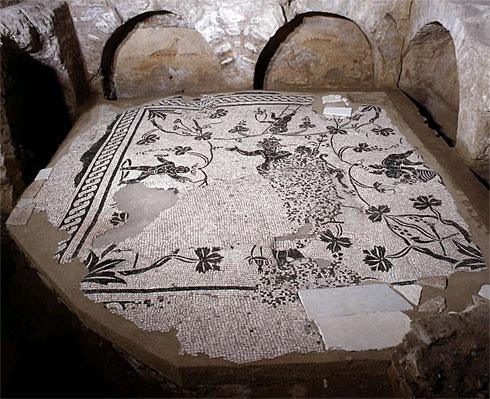 Mosaic of Dionysus in a vineyard with goat-legged satyr found in Vatican necropolis Those buried in the tomb are described as being a mix of both social class and religious beliefs. One Vatican museum archaeologist, Cristina Gennaccari, described the necropolis as belonging to people “on the verge of conversion to Christianity.” One sepulcher decorated with angels is believed by Vatican archaeologists to have belonged to a woman who was Christian. Another tomb of a 17-year-old Roman knight, portrays the picture of a woman with arms outstretched in prayer, a common depiction in early Christianity art known as “orant.” Gennaccari describes this as a potential belief in Christianity, saying, “It brings him into the Christian realm.” In another tomb, a pre-Christian symbol of resurrection, a hen’s egg left, is left beside the body of an infant. Another tomb belonged to the set designer for Pompey’s Theatre, where Julius Caesar was killed, as well as mailmen and an archivist under the employ of Nero. 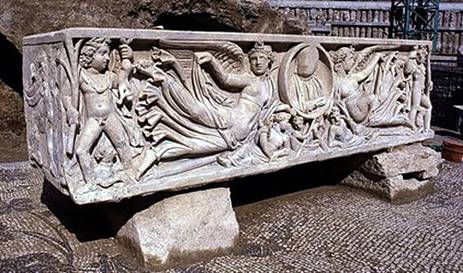 Sepulcher of woman believed by Vatican archaeologists to be a Christian This is not the first archaeological find to show an intermixing of early Christianity and the Orphic mysteries. Many other ancient Roman artifacts, most of them dating from the 300’s A.D., also show definite links between the two religions. The first three of these I will show are referenced in Joseph Campbell’s fourth book in his Masks of God series: Creative Mythology. Campbell’s book provides a drawing of the restored ceiling of the Domitilla Catacomb in Rome, with are eight panels circling the dome (p. 7). Four of the panels exhibit scenes from the Bible and four of them show pastoral scenes of a bull (the pagan sacrificial animal) or a ram (a Jewish sacrificial animal). The Bible scenes include: Moses drawing water from the rock, David with his sling, Daniel being cast into the lion’s den, and Jesus resurrecting Lazarus using a wand similar to the augur‘s wands used by the Roman priestly class. In the center of the eight panels is Orpheus playing the lyre. 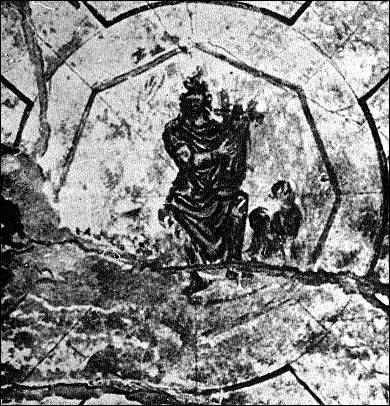 Christian catacomb in Rome, portraying Orpheus sitting with a lyre in center panel with animals and trees, Surrounding panels portray Biblical scenes dated 300s A.D. The second archaeological artifact is a sacramental bowl of gold with 16 figures adorned around the inside of it, each of them representing a station of existence from life to death to rebirth. The bowl was dug up in 1837 in the town of Pietroasa, in Romania, and is generally believed to have been fashioned in the 200s or 300s A.D. Many scholars who examined the treasure that was included with the bowl thought it might have been buried by the Visigoth king Athanaric when he fled from the Huns in 381 A.D. Unfortunately, the whole collection was taken from Germany during World War I and melted down for gold by the Russian Soviets before it was ever properly dated. Luckily, it had been photographed and galvano-plastically reproduced while on loan for six months in England, between 1867 and 1868. The figure in the first station is that of Orpheus as Dionysus, holding the figurative shepherd’s staff, symbolizing kingship over his “sheep,” and the fisherman’s net, making him a “fisher of men.” Behind him grows wheat and bread, symbolizing the bread and wine of eternal life. In station three is a man (possibly a new convert) with the raven of death on his shoulder, his eyes set on Dionysus as he plucks a pinecone, symbolizing rebirth, from a sacred chest held by a naked figure in station two. In his other hand is a torch to light his journey through the netherworld. Moving clockwise around the bowl past other mystical figures, the 10th station shows the Lord of the Abyss enthroned on the head of a Leviathan-like serpent. Stations 12 and 13 contains two similar-looking men who may represent the twin motif, in which one twin is mortal and the other immortal, such as the Roman mythological figures, Castor and Pollux (respectively); the Greek heroes, Iphicles and Heracles; or the Gnostic sages, Thomas and Jesus. The man returns from the netherworld in station 14, carrying a staff and presenting a basket to a draped woman in station 15. In station 16, having come full circle, Apollo sits with his lyre, a griffon sitting beneath him. In the center of the bowl is a goddess, sitting on a vineyard stump, holding a chalice equivalent to the Holy Grail. Taken as a whole, the 16 stations represent a spiritual journey from life to death to resurrection. A similar theme is explored in the Book of Jonah in which Jonah willingly allows himself to be swallowed by a giant fish and spends three days in its belly before coming back to earth. The “Sign of Jonah,” as referenced by Matthew and Luke, compares the three days and nights Jonah spent in the fish’s belly to the three days and nights the Son of Man would spend in the belly of the earth, although technically there are only two days between Good Friday and Easter Sunday. 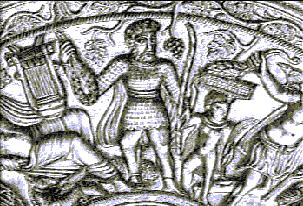 Orphic Sacramental Bowl from Pietroasa, Romania, 200s or 300s A.D. Orpheus holding a fisher’s net and staff, wheat and grapes growing above his shoulders Another piece of archaeological evidence is a talisman or cylinder seal depicting a figure nailed to a cross, with a half moon and seven stars residing overheard. Across the bottom reads, “Orpheus Bacchus,” Bacchus being the Roman name for Dionysus. This artifact came to an unfortunate end as well. It was kept in the Berlin Museum until it was lost or destroyed during the Second World War and it’s image has only survived in a black and white photograph of it. This ornament features in both Campbell’s book as well as the cover of the book, The Jesus Mysteries: Was the “Original Jesus” a Pagan God?, by Timothy Freke & Peter Gandy. The last two artifacts are featured in Freke and Gandy’s book as well. 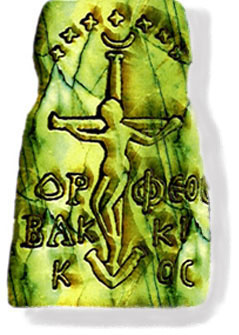 Talisman or cylinder seal of Orpheus-Bacchus Crucified (False color) The next artifact is a marble sarcophagus from Rome, dated to the 100s or 200s A.D., of Dionysus as a baby, in which an older man carries a staff-sized cross with the image of a crucified man on it, in what could only be interpreted as a device prophesizing his ultimate fate.  Marble sarcophagus of baby Dionysus dated between 100s - 200s A.D. An older man brings a cross symbolizing his crucifixion Next up are two Greek vases dating to the 400s B.C., showing the armless and legless form of Dionysus on a pole with sprouting branches, signifying his death on a tree. His form overlooks the female revelers who drink wine in remembrance of him. The second vase, dating to the 500s B.C. portrays a similar form of Dionysus, this one lacking a face along with the arms and legs, as two female followers take bread and wine in a pagan communion. Above the pole is a crossbar, making it a cross, but there are also six tree branches coming off it, which also makes it a tree. The lack of a face signifies his death, which the initiates take part in through partaking of his blood in the form of wine. The pole that represents his body is equivalent to the “Asherah poles” of the Dumuzi/Tammuz fertility cult of Sumer and Canaan which were destroyed through Yahweh’s command by the Biblically revered Judean kings, Hezekiah and Josiah. On a marble sarcophagus dating from the 100’s or 200’s shows men lifting up a great pillar representing his crucifixion during the Spring Festival, which is equivalent to Easter. In Greece, these traditions were greatly despised and repressed by the cultural elites but greatly tolerated on the fringes of society. The situation was sometimes similar in Judah. In Judah, the death of Ba’al or Tammuz was worshipped in the form of Asherah pole, named after his wife, the fertility goddess equivalent to Aphrodite. These poles represented the tree on which the god had been hanged, and incense was burned to it. These cults had the most popularity among pastoral people who went to “high places” to worship Yahweh and Asherah instead of the temple in Jerusalem. In the books of Kings and Chronicles, kings like Hezekiah and Josiah were praised as godly for going to these “high places” and chopping down the Asherah poles. It is not hard to imagine that some of these Asherah poles may have taken the form of crosses. Hezekiah even took the bronze caduceus Moses had crafted to heal the Israelites and broke it, calling it “Nehushtan” (or “unclean thing“). According to 1 Kings, he broke this ancient artifact “because the Israelites had been burning incense to it.” (18:4). All of this was violence perpetrated by Hezekiah and Josiah was done on behalf of the laws of Moses, which said that Yahweh alone was to be worshipped and that sacrifices were only to be made in Solomon’s Temple. 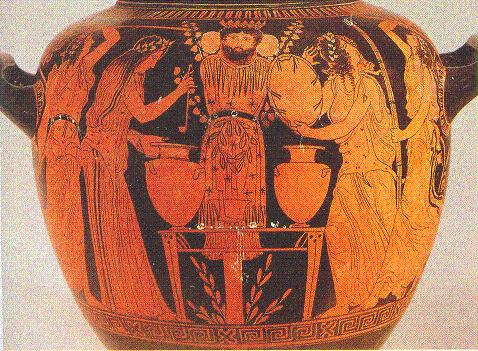 Vase of Dionysus on a pole, crowned in ivy as worshippers dance and drink wine 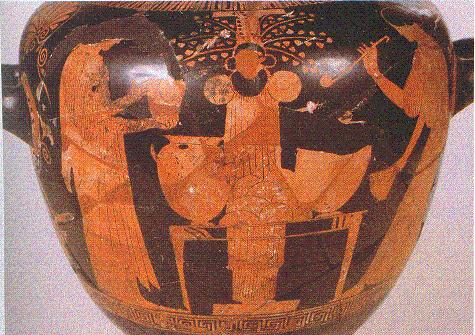 Dionysus crucified on a cross-tree as initiates take bread and wine 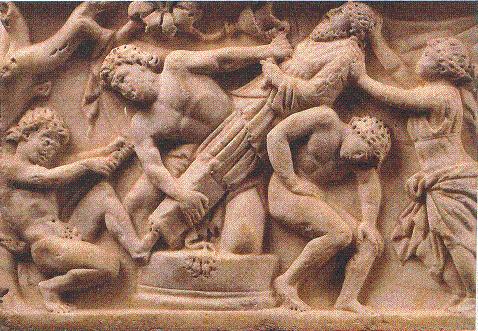 Sarcophagus from 200’s or 300’s of Dionysus pole being lifted at Spring Festival All three pictures taken from The Jesus Mysteries, by Timothy Freke and Peter Gandy And finally, in 1666, an ancient wooden chair was installed in the cathedra to St. Peter at Rome by Gian Lorenzo Bernini which was overlaid with ivory plaques depicting the Labors of Hercules and some Zodiac signs. I first became aware of the chair after seeing it a tour of Vatican artifacts put on by the Roman Catholic Church at the Houston Museum of Natural Science. Although the New Advent Catholic Encyclopedia suggests that the original Chair of St. Peter was lost to invading Goths when they pillaged Rome in 410, the later chair was largely venerated at the time as the original Episcopal throne. It is an otherwise plain arm-chair of acadia wood encased in worm-eaten oak, with pieces that have been cut from various spots at different times, evidently for relics. To the right and left of the seat four strong iron rings, intended for carrying-poles, are set into the legs. It’s generally believed to date back some time around the 800’s A.D. 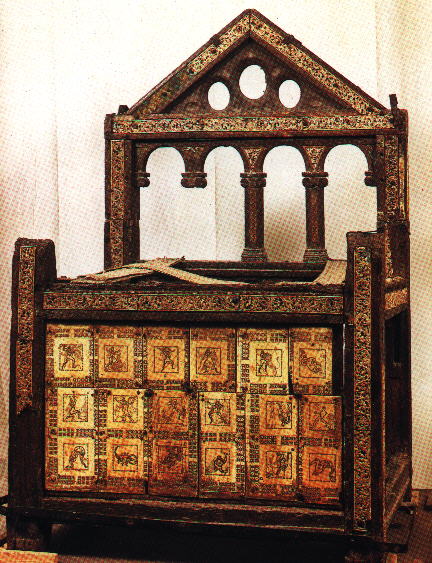 “St. Peter’s Chair” from Roman Cathedral, dated to around 800’s A.D. Images on the chair portray Labors of Hercules and pagan Zodiac signs Prophets of Theos Heroditus is the first known writer to equate Dionysus with the Egyptian god of death and resurrection, Osiris, as early in the 400’s B.C. and the composite name of Osiris-Dionysus was used in the first century B.C. by Leon of Pella and also Hecateus of Abdera in his work Aegyptiaca. In later times, Gnostics and Neo-Platonists expanded on this syncretism to include Adonis, Attis, and Mithras, although the most popular name they used was Aion. Many pagans, including second century philosopher Celsus, argued that the gospels were based on the suffering and death of Dionysus and other pagan gods. Justin Martyr in turn asserted that the pagan mystery cults were instead based on the prophecies from the Old Testament. He considered Orpheus to be a monotheist, along the same lines as Pythagoras, Sophocles, and Plato, but like Philo and Josephus, he believed that all Greek monotheism had been influenced by Moses. He even tried to make the argument that demons had retro-actively copied the life and death of Jesus into the past: But those who hand down the myths which the poets have made, adduce no proof to the youths who learn them; and we proceed to demonstrate that they have been uttered by the influence of the wicked demons, to deceive and lead astray the human race. For having heard it proclaimed through the prophets that the Christ was to come, and that the ungodly among men were to be punished by fire, they put forward many to be called sons of Jupiter [Zeus], under the impression that they would be able to produce in men the idea that the things which were said with regard to Christ were mere marvelous tales, like the things which were said by the poets. And these things were said both among the Greeks and among all nations where they [the demons] heard the prophets foretelling that Christ would specially be believed in; but that in hearing what was said by the prophets they did not accurately understand it, but imitated what was said of our Christ, like men who are in error, we will make plain. The prophet Moses, then, was, as we have already said, older than all writers; and by him, as we have also said before, it was thus predicted: “There shall not fail a prince from Judah, nor a lawgiver from between his feet, until He come for whom it is reserved; and He shall be the desire of the Gentiles, binding His foal to the vine, washing His robe in the blood of the grape.” [Genesis 49:10] The devils, accordingly, when they heard these prophetic words, said that Bacchus was the son of Jupiter, and gave out that he was the discoverer of the vine, and they number wine [or, the ass] among his mysteries; and they taught that, having been torn in pieces, he ascended into heaven. And because in the prophecy of Moses it had not been expressly intimated whether He who was to come was the Son of God, and whether He would, riding on the foal, remain on earth or ascend into heaven, and because the name of ‘foal’ could mean either the foal of an ass or the foal of a horse, they, not knowing whether He who was foretold would bring the foal of an ass or of a horse as the sign of His coming, nor whether He was the Son of God, as we said above, or of man, gave out that Bellerophon, a man born of man, himself ascended to heaven on his horse Pegasus. And when they heard it said by the other prophet Isaiah, that He should be born of a virgin, and by His own means ascend into heaven, they pretended that Perseus was spoken of. And when they knew what was said, as has been cited above, in the prophecies written aforetime, ‘Strong as a giant to run his course,’ they said that Hercules was strong, and had journeyed over the whole earth. And when, again, they learned that it had been foretold that He should heal every sickness, and raise the dead, they produced Aesculapius.” -Justin Martyr, First Apology, Ch. 54 The argument is a very poor one to be sure. The concept that demons inspiring many sons of God to appear before Jesus in order to discredit him is an argument akin to the one that says God places fossils that predate the Bible era into the ground in order to test people’s faith. Many of these sacrificial religions that supposedly copied off the Hebrew prophets predate the Hebrew prophets; some predate the Hebrews. Moses was most definitely not “older than all writers.” Some of the “prophecies” mentioned are based on highly exegetical secondary meanings that have been applied to the text in addition to their primary meaning. For example, Isaiah’s sign was primarily meant for his own time, only in his language the word almah meant “maiden,” not “virgin.” The quote from Genesis seems to have a strikingly Christian theme, but Justin fails to finish the quote, which says: “His eyes will be dull from wine, his teeth white from milk.” Certainly he did this on purpose since anyone would immediately recognize the description as pertaining more to Bacchus than to Jesus. The Athenian poet Euripides, a contemporary of Socrates, also wrote a play on Dionysus called The Bacchae, one of only 19 that survived out of the hundred or so plays Euripides was said to have written in his lifetime. It’s said he grew up and served as a cupbearer for the dancers of Apollo, but came to question his religion when exposed to the ideas of Socrates, as well as other important philosophers such as Anaxagoras and Protagoras. This new wave of thinking coalesced into Euripides’ plays, giving a more modern element of focusing on the inner lives and motives of the play’s characters. He’s believed to have been wealthy and was married to two women, Choerile and Melito, fathering three sons and a daughter. His plays were performed during the Dionysia festival, the second most important event in Athens, after the Panathenaic Games. It was originally a rural festival held in the winter month of Poseidon. It was also an important part of the Dionysian Mysteries. The central event was a procession, known as the pompe, in which the theatre of Dionysus was made pure through the sacrifice of a young piglet. Starting in 534 B.C., a competition was held to find the best tragic playwright, and after five days of tragedies, the sixth day of the festival was devoted to comedies. The winner of the first recorded Greek tragedy competition was Thespis, who was said to be the first costumed script actor of the western world, and from whom the word thespian (meaning “tragedian“) comes from. Writing some 80 years later, Euripides entered into his first competition, but only came in third, supposedly because he didn’t coddle to the expectations of the judges. His writings went against tradition, ridiculing mythic heroes and portrayed women and slaves as having strong character and intelligence. He won his first prize 14 years after his first competition, but despite having produced so large number of plays won only 5 victories throughout his life, the last one awarded after his death for The Bacchae. Many elements found in Acts of the Apostles can be traced back to The Bacchae. When Paul is struck down on his way to Damascus in Acts of the Apostles, he sees an image of Jesus saying, “Saul, Saul, why do you persecute me? It is hard for you to kick against the goads.” (26:15). The reference was to a spiked wooden instrument used to goad an ox along, Hence, just as an ox would only injure itself the more it resisted, Paul was only injuring himself by rebelling against God. The term “kick at the goad” is used by Dionysus against Pentheus, the king of Thebes who bans Dionysian worship and in the play wishes to have a mysterious stranger, who is Dionysus in disguise, stoned to death. Dionysus tells Pentheus, “I'd sooner make an offering to that god than in some angry fit kick at his goad-- a mortal going to battle with a god.” Peter is miraculously saved from prison in Acts of the Apostles, with the shackles around his wrist breaking and the prison door opening when an angel comes down to save him (12:7). Chains also miraculously fall off of Paul and Silas when an earthquake hits as they are praying to God from within in a Philippian prison (16:25). In The Bacchae, a solider tells Pentheus that the Maenads he had locked up escaped, saying, “They're gone-- playing around in some meadow, calling out to Bromius [Dionysus], summoning their god. Chains fell off their feet, just dropping on their own. Keys opened doors not turned by human hands. This man here has come to Thebes full of amazing tricks. But now the rest of this affair is up to you.” Like Jesus, Dionysus allows himself to be arrested and is interrogated by Pentheus in a way very similar to how Jesus is interrogated by Pontius Pilate. In the Gospel of John Jesus says, “You would have no authority at all over me, had it not been granted from above.” (19:10), similar to Dionysus saying, “Nothing can touch me that is not ordained.” (line 547). In the Gospel of Luke, Jesus says “Father, forgive them, for they know not what they are doing.” as he is being crucified. In The Bacchae, Dionysus tells Pentheus: “You know not what you are doing, nor what you are saying, nor who you are.” (line 484). Divine retribution is similarly promised in the poem, in which Dionysus says, “But I warn you: Dionysus who you say is dead, will come in swift pursuit to avenge this sacrilege.” (line 548). Pentheus, wanting to spy on the Maenads performing their Bacchic rites, dresses up like a woman and is led by Dionysus into the forest where they are performing the rite. Dionysus bends a great pine down and places Pentheus on the top so that the king can see better, but he then calls on the Maenads to pull the tree out, causing him to fall, and Pentheus is ripped apart by the frantic women, led by Pentheus’ mother. The use of the tree may have been meant a symbolic reversal of Dionysus’ own death on a tree, similar to how Judas takes the place of Jesus in some Gnostic myths. Pentheus’ mother carries his head back to the city and only then realizes what she had done. This fulfills what Dionysus had already foretold in saying Pentheus would be carried back by his mother, though the king assumed he had meant he was going to be pampered, which Dionysus substantiated by admitting he was going to be “spoiled.” The Greek poet Menander was a great admirer and imitator of Euripides, and it is from his play, Thais, that the First Epistle to the Corinthians takes the line, “Evil companions corrupt good morals.” (15:33). St. Clement of Alexandria quoted much from Euripides, Homer, and Menander, one quote from Euripides being, “Look on the ether and heaven, and regard that as God.” In Chapter 11 of Book 5 of Stromata, (“Miscellanies”), Clement claims that Euripides had somehow come to knowledge of the Son of God through the use of metaphor: “Euripides, the philosopher of the drama, is found in the following words-- making allusion, I know not how, at once to the Father and the Son: “‘To you, the Lord of all, I bring Cakes and libations too, Oh Zeus, Or Hades would you choose to be called; Do you accept my offering of all fruits, Rare, full, poured forth?’ “For a whole burnt-offering and rare sacrifice for us is Christ. And that unwittingly he mentions the Savior, he will make plain, as he adds: “‘For you who, ‘among the heavenly gods, Jove’s [Zeus‘] sceptre sways, do also share The rule of those on earth.’” “Then he says expressly: “‘Send light to human souls that fain would know Where conflicts spring, and what the root of ills, And of the blessed gods to whom due rites Of sacrifice we needs must pay, that so We may from troubles find repose.’ “It is not then without reason that in the mysteries that obtain among the Greeks, lustrations hold the first place; as also the laver among the Barbarians. After these are the minor mysteries, which have some foundation of instruction and of preliminary preparation for what is to come after; and the great mysteries, in which nothing remains to be learned of the universe, but only to contemplate and comprehend nature and things.” -Clement of Alexandria The 17th chapter of Acts quotes two more Greek poets, saying, “From one man he made every nation of men, that they should inhabit the whole earth; and he determined the times set for them and the exact places where they should live. God did this so that men would seek him and perhaps reach out for him and find him, though he is not far from each one of us. ‘For in him we live and move and have our being.’ As some of your own poets have said, ‘We are his offspring’ .” (17:26) The first quote comes from Epimenides of Knossos, a philosopher, poet, and prophet from Crete who lived some time around the 500s B.C. In his poem Cretica, the Cretan god Minos says to Zeus, “They fashioned a tomb for thee, O holy and high one-- The Cretans, always liars, evil beasts, idle bellies! But you are not dead: you live and abide forever, for in you we live and move and have our being.” “Cretans, always liars” also appears in the “Hymn to Zeus,” written in the 200s B.C. by Callimachus, a poet and scholar from the Library of Alexandria. In both works, the “lie” the Cretans are accused of is claiming that Zeus was mortal. The second quote from Acts comes from the Stoic poet, Aratus of Soli, also living in the 200s B.C., who wrote in his principle work, Phaenomena in honor of the Macedonian king Antignous II Gonatas for his victory over the Gauls. The poem reads: “Let us begin with Zeus, whom we mortals never leave unspoken. For every street, every market-place is full of Zeus. Even the sea and the harbor are full of this deity. Everywhere everyone is indebted to Zeus. For we are indeed his offspring.” Thus, according to Acts, a henotheistic appropriation of Zeus is associated with the god of the Jews. Even the word that Acts and the rest of the New Testament uses for God, Theos, is a cognate of the name Zeus. The Greek poets are likewise made out to be equivalent to the Jewish prophets. This is in stark contrast to contemporary Jewish philosophers like Philo and Josephus who drew a distinction between the prophets as divine oracles and Greek philosophers as uninspired prodigies.
Acts’ insult towards the Cretans is repeated in the Pastoral Epistle to Titus, where “Paul” leaves Titus in charge of Crete to straighten the people there out: “For there are many rebellious people, mere talkers and deceivers, especially those of the circumcision group. They must be silenced, because they are ruining whole households by teaching things they ought not to teach -- and that for the sake of dishonest gain. Every one of their own prophets has said, ‘Cretans are always liars, evil brutes, lazy gluttons.’ This testimony is true. Therefore, rebuke them sharply, so that they will be sound in faith and will pay no heed to Jewish myths or the commands of those who reject the truth.” (1:10). The verse has often been used as an example of what’s called the Epimenides Paradox, formulated in 1908 or earlier, saying that: if the term “liar” is defined as someone whose every statement is a lie and if the verse is taken literally, then the verse itself would have had to have been a lie since Epimenides was himself from Crete. Of course, when Epimenides said it, he was using it as a generalization, and neither he nor those who quoted the verse took it in any ironic sense. According to Clement of Alexandria, Epimenides was considered by many to be one of the seven wisest philosophers, although he was not among the standard list of the Seven Sages of Greece. Unlike most Cretans, he let his hair grow long and unshaven. In the Life of Epimenides, written by Diogenes Laertius in the 200s A.D., he is said to have gone to Athens where he helped put an end to a plague by letting loose a number of black and white sheep and having his attendants follow them to wherever they laid down and then sacrificed them “to the god who was the patron of the spot, and so the evil was stayed; and owing to this one may even now find in the different boroughs of the Athenians altars without names, which are a sort of memorial of the propitiation of the Gods that then took place.” This story may be the inspiration behind the verse in Acts immediately preceding the Epimenides quote in which Paul is said to have noticed an altar with an inscription “to an Unknown God.” (17:23). St. Jerome had suggested that the original inscription had read “To the gods of Asia, Europe, and Africa, to the unknown gods,” which, as mentioned in the first chapter, Desiderius Erasmus took to be also typical of the contextual distortions of his own present-day “sons of theology.” According to The Acts of the Apostles: A Socio-Rhetorical Commentary, by Ben Witherington, an fragmentary inscription found not in Athens but near the Temple of Demeter in Pergamon in western Turkey and dated to the 200s A.D. appears to have read: “to gods unknown, Capito the torch-bearer [dedicated this altar].” This would lead to some evidence for the possibility of a shorter version closer to what’s written in Acts, although it still dedicated to unknown gods rather than an Unknown God. However, if there were stories told of Epimenides saving Athens prior to Acts in which “altars without names” were constructed, as Diogenes later attests to, then it stands to reason that the altar “to an unknown God,” mentioned only three verses before the Epimenides quote is itself a reference to that legend. According to Diogenes, some had recorded the plague Epimenides had stopped as being caused by the “pollution contracted by the city in the matter of Cylon, and that Epimenides pointed out to the Athenians how to get rid of it, and that in consequence they put to death two young men, Cratinus and Ctesilius, and that thus the pestilence was put an end to.” Cylon, or Kylon, was an Athenian noble and Olympic Game winner who attempted a coup in one of Athens’ earliest recorded events in 632. When the Oracle of Delphi told Cylon to attempt a coup during a festival of Zeus, he wrongly took it to mean the Olympic Games, and finding more resistance than he anticipated, tried to declare sanctuary in Athena’s temple on the Acropolis. Cylon and his brother escaped, and his followers agreed with the city’s nine archons to stand trial if their lives would be spared. Tying a rope to the temple, they surrendered. According to Plutarch, the rope broke on its own accord and they were stoned. Others said that the famous archon Megacles had them killed and that his entire noble family, the Alcmaeonidae, was cursed and banished from the city for 38 years for breaking sanctuary laws. Thus the plague mentioned by Diogenes was believed by some to have been caused by Megacles’ curse. Diogenes Laertius also writes that some authors are said to have claimed that the Cretans sacrificed to Epimenides as a god because while he was in Athens he correctly predicted that the port of Munychia would bring their downfall. Others said that he predicted that the Lacedaemonians would be defeated by the Arcadians and that because of his a treaty of friendship and alliance was made between Knossis and Athens. He is also said to have fallen asleep in Zeus’ cave in Crete for 57 years, or to have pretended to have lived several times, or to have pretended to have grown up rapidly, or to have left Crete for a long time while doing an anatomization of roots, and is said to have died at the age of 154, 157, or according to the Cretans, 209. After his death, it is said that his skin was preserved in Sparta to bring the warriors there good luck. Tattoos were said to have been found on his skin, which was strange because at the time only slaves were known to have tattoos. Some scholars have suggested that they are related to shamans of Central Asia who were known to carry tattoos. We should also recall that the Talmud accused Yeshu ben Stada of bringing “enchantment out of Egypt in the cutting which is in the flesh,” which, as Frank Zindler showed, has matching references to Yeshu/Jesus cutting the name of God into his side in the Toldoth and Book of Revelation. Its said that Epimenides’ skin was preserved in Sparta to bring the Spartan warriors good luck. Epimenides was also associated with the Eleusinian Mysteries of Demeter and Persephone in some ways. In Inventing Ancient Culture: Historicism, Periodization and the Ancient World, by Mark Golden and Peter Toohey, it is noted that Plutarch claimed he had initiated the city in secret rites. He was also identified with Byzousgas, an agricultural hero who was said to have invented the plough, and that both were associated with the hieros arotos, or “sacred labor,” which connected ritual activities in Athens and Eleusis together. A seated statue of Epimendes was also said to have been placed in front of the Eleusinion temple in Athens. According to Diogenes Laertius, Epimendes wrote a poem on the Curetes and Korybantes, worshippers of the goddess Rhea, the Cretan incarnation of Cybele, who, like the Maenads, took part in ecstatic dancing amongst wine-drinking and music. Korybantes were also said to have presided over the infancy of Dionysus and Zagreus. Epimendes is also said to have written a poem on Jason and the Argo and a treatise on the sacrifices of Crete, the Cretan Constitution, and Minos and his brother Rhadamanthus. Diogenes also cites Lobon the Augur as crediting Epimendes for building the first temple in Athens, which he dedicated to the goddess. Sexuality in Ancient Times Even though Orphic cultists had a reputation as being abstinent, Orpheus himself was popularly believed to have been the first to bring pederasty, the sexual relationship between an older man and a younger boy, into Thrace. The Greek poet Ovid, who was highly regarded by the Emperor Augustus before he was banished from Rome in 8 A.D., also wrote about the priest Orpheus. In the 11th Book of Ovid‘s Metamorphesis, the Maenads are angered at him because in his grief over his wife, he has forsaken women in favor of young boys and has taken their husbands away from them. At first they lunge sticks and stones at Orpheus, but his gentile music tames even inanimate objects, which fail to strike him. After the Maenads drink themselves into a frenzy, they are able to overcome the beauty of his song and massacre their husbands before tearing Orpheus apart. His head and lyre were said to have gone down the Hebrus River, into the Mediterranean Sea and washed up on the Isle of Lesbos. There his head was buried with a shrine built in his honor. The nine Muses, who inspired men in the arts and sciences, took his lyre and made it one of the constellations in the heavens. They buried the rest of his remains in the city of Lebethra, near Mount Olympus. Nightingales were said to have sung over his grave and his soul became reunited with his beloved Eurydice. 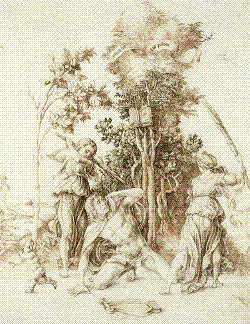 Death of Orpheus, ink drawing by German Painter, Albrech Durer, 1494 A.D. The ribbon on the tree reads, “Orfeus der erst puseran,” (“Orpheus, the first pederast”) In Ovid‘s time, bisexuality was the norm for men, with both heterosexual and homosexual exceptions, yet lesbianism was uncommon enough to be considered shocking. Pederast relationships were common throughout the aristocratic class in Greece and Rome throughout the Classical era. It was idealized that the younger male should put up resistance, but only as a pretense. The act of older men fondling young boys was even depicted on some Greek vases. Kissing and fondling are believed to have been the general extent of it; to the ancient Greek mind, a man was greatly shamed at being penetrated. Ovid himself lamented that he had neither a woman nor a young boy to write his love poems about. In Plato’s Symposium, Socrates attends a Dionysian festival in Athens and gets into a conversation about the philosophy of love. He says that everything he learned about love was from a priestess named Diotima. Diotima tells him that Love is not a god since love desires beautiful things, and so must be half mortal, and like all sons of gods, acted as messengers between heaven and earth. Diotima taught Socrates that he mistook love for being loved instead of being a lover. True love is the desire to possess the good forever, seeking immortality through reproduction, either in body or soul. Those who became pregnant in body sought to provide themselves with “immortality and remembrance and happiness,” while those pregnant in soul bear “wisdom and rest of virtue, which all poets beget, as well as all the craftsmen who are said to be creative.” The rites of love taken by one pregnant in soul, when done correctly, are said to be the final and highest mystery, though she is unsure that Socrates is capable of it. One pregnant in this way must devote himself to beautiful bodies in his youth, because only then will he see that the beauty of all bodies is one and the same. With this, one comes to see that the beauty of one's soul is more valuable, and seeks to help young men become pregnant in the soul to give birth to ideas. After Socrates explains all this, a drunk young friend named Alcibiades, an important politician and general, begins to hit on Socrates despite the fact that Plato repeatedly describes Socrates as being ugly. Alcibiades compares Socrates to a statue of Silenus, an old Dionysian teacher: the statue itself was ugly and hollow, but the inside was filled with tiny golden gods. Socrates repeatedly spurns his advances, but this only angers Acibiades because he believes that Socrates is just leading him on, “as if I [Alcibiades] were the lover and he my young prey!”. Although Alcibiades had had numerous male lovers, he was unable to realize a “productive” sexual relationship. He tries to realize this with Socrates, saying that he is the only worthy lover he had ever known, and that Socrates was the most fit to make him the best man he can be. Socrates responds that even if that were true, which he is unsure of, he wouldn’t want to trade his inner beauty for Alcibiades’ image of it. The two part, but later that night Alcibiades sneaks under Socrates’ cloak in order to seduce him, but fails. In his early works, Plato says he knows of no greater blessing for a young man than to have a virtuous male lover, and even goes to say that if any army or state were made entirely of lovers, then they could never be defeated. But when pederasty began to cause great civil strife within Athens, he recommended in his later dialogue, Laws, that there should be a law set against sexual intercourse with boys, as well as other indiscretions like adultery. Plato acknowledged that most Greeks of his time would have believed such prohibitions impossible. Plato’s student, Aristotle, who was more interested in natural science and biology, saw pederasty as an abnormality brought on either by a natural disorder or by habit. Several ancient sources speak of his pupil, Alexander the Great, having a male lover, Hephaestion, who died under mysterious circumstances, possibly killed by Alexander’s wife, Roxanne. However, some scholars have noted that none of these sources date from Alexander’s time period and suggest that there is no definitive proof of his sexuality. Alexander and his father, Phillip II, were also known to have defeated the Sacred Band of Thebes in 378 B.C., an elite force of 150 paired homosexual lovers who acted as a “crack” force for 40 years during the Theban dominance of Greece. When the Bacchus cult was introduced to Rome in 200 B.C., it had originally been confined to women only. They were said to of performed their Bacchanal orgies in secret only once every three years. In Rome Semele was called Stimula, and an unfinished poem by Ovid speaks of Italian Maenads originating from Arcadia in southern Greece. According to the Roman Historian, Titus Livius, who lived during the turn of the first century, it came to be performed five days a month under the direction of one, Paculla Annia. She also supposedly ruled that men would be allowed to participate in the orgies, but only innocent young men below the age of 20. Under her guidance, her orgies grew more and more perverse in an attempt to break any law of nature ever conceived, according to Livy. Those who refused to participate, were supposedly sacrificed. Although modern scholars have put much doubt behind Livy’s investigation, the Senate is said to have issued a decree banning the cult in 186 B.C. Livy also described the national god Romulus in terms similar to those found in the New Testament. Romulus was said to have been a son of a god, born from Mars and the virgin goddess Rhea Sivius, and is said to have descended from heaven in order to tell Rome that heaven willed it to be capital of the world. Livy describes the death of Romulus by saying that he was looking over his soldiers on Campus Martius when a storm broke out, enveloping him in a cloud. In the Acts of the Apostles, Jesus is also said to have ascended to heaven from Jerusalem in a cloud. Livy also says that the Roman senators believed Romulus to have been caught up in a whirlwind, symbolism used for being martyred, similar to the way Elijah is said to have disappeared. The Bible is largely seen to be roundly against all forms of homosexuality, but the situation is actually far more subtle. The story of Sodom and Gomorrah is often seen as antagonistic towards homosexuality in general, although it is rarely mentioned that the antagonists in the story are actually a gang of rapists. There is even a doublet of the story, written by the same author, in Judges in which another gang of heterosexual rapists murder a slave woman, bringing about the destruction of their city in much the same way the Sodomites do. In the Genesis story, the “righteous” nephew of Abraham, Lot, tries to placate the gang of Sodomites by offering up his two virgin daughters for them to rape, but they refuse. The two angels of God help Lot’s family escape before they destroy the city and Lot later gets drunk and is seduced by his daughters, who give birth to Moab (father of the Moabites) and Ben-Ammi (father of the Ammonites). The Book of Leviticus holds that if a man has sex with another man, they are both to be put to death (20:13). However, even though there are two different laws for having sex with animals, one for men and one for women, there is no law banning lesbianism. And, of course, the Torah’s ban must be kept into context with the fact that sleeping with another man’s wife, blasphemy, and working on the Sabbath day were all punishable by death as well. King David himself is certainly described in the Bible as having a relationship with Saul’s son Jonathan that went beyond mere friendship. In the 18th chapter of 1 Samuel, it says, “After David had finished talking with Saul, Jonathan became one in spirit with David, and he loved him as himself. From that day, Saul kept David from him and did not let him return to his father’s house. And Jonathan made a covenant with David because he loved him as himself. Jonathan took off the robe he was wearing and gave it to David, along with his tunic, and even his sword, his bow and his belt.” Jonathan and David later reaffirm this oath, and David is said to love Jonathan “as he loved himself.” (20:17). When Jonathan returns to his father, Saul scolds him saying, “You son of a perverse and rebellious woman! Don’t I know you have sided with the son of Jesse to your nakedness [shame] and to the nakedness [shame] of the mother who bore you?” (20:30). After Saul and Jonathan are killed by the Philistines, David is said to have written a lament, which the author of 2 Samuel quotes from the Book of Jasher, in which David says that Jonathan’s love for him was “more wonderful than that of a woman.” (1:26). If David was a bard in a Orphic style -- and dancing around naked really does not help in ruling the idea out -- it’s possible that there is more meaning to the phrase from Genesis “teeth white with milk” than the generally believed. In 1 Kings, the prophet Elijah resurrects a dead boy by lying on top of him (17:21). This is described in greater detail in 2 Kings when Elijah’s successor, Elisha, tells a man named Gehazi to lay Elisha’s staff on the boy‘s face. When that doesn‘t work, Elisha prays to Yahweh and gets on the bed to “lay on the boy, mouth to mouth, eyes to eyes, hands to hands. As he stretched himself out on him, the boy’s body grew warm. Elisha turned away and walked back and forth in the room and then got on the bed and stretched out on him once more. The boy sneezed seven times and opened his eyes.” (4:32). Timothy Koch argues in Cruising as Methodology: Homoeroticism and the Scriptures that the staff is a phallic symbol and that the “sneezing” was meant to refer to ejaculation. It has also been suggested that this was a form of mouth-to-mouth resuscitation used on boys suffering from sun stroke, although it is hard to imagine the need for it to be “eyes to eyes, hands to hands.” According to the Pauline epistles, the laws of Moses are no longer in effect, which would include the ones prohibiting male homosexuality. The first chapter of Romans has Paul talk about how God was known from the beginning of time but that idol worshippers “exchanged the glory of God for images made to look like mortal man and birds and animals and reptiles. Therefore, God gave them over to shameful lusts. Even their women exchanged natural relations for unnatural ones. In the same way, men also abandoned natural relations with women and were inflamed with lust for one another. Men committed indecent acts with other men, and received in themselves the due penalty for their perversion.” (1:23). The epistle 1 Corinthians says that arsenokoitai, or “male-bedders,” will not inherit the kingdom of heaven (6:9), but lists them along with the wicked, adulterers, male prostitutes, thieves, the greedy, drunkards, slanderers, and swindlers. It is widely debated whether the term referred to (a) any kind of homosexual sex, (b) those who slept with enslaved male prostitutes, or (c) those who engaged in cultic sex. It’s often noted that the condemnation of “male-bedders” tends to go hand-in-hand with idol worshippers and slave traders, such as in 1 Timothy (1:10). Like some Christian sects, there were pagan mystery cults that were said to have engaged in strange and often orgiastic behavior. Cults to Dionysus or Hercules would sometimes involve priests and other devotees to dress up in women’s clothing. Other cults involved men and women switching their clothing. It may well be that this kind of ritualistic cross-dressing may have been one of the targets of epistle’s polemic. Hercules himself was known to have taken on many young male lovers, although this was seen as far more normal in Greek and Roman society than switching gender roles. There has also been much doubt expressed in modern scholarship like that of the Episcopal bishop John Shelby Spong that Paul was familiar with the modern cultural understanding of the monogamous homosexual. The Episcopalian Church itself has long been in the forefront of the modern controversy regarding open homosexuality in the church. In November of 2003, the Episcopalian church inaugurated an openly gay bishop, causing great ripples within it‘s parent body, the Anglican church, most especially in Africa. Jesus says nothing about homosexuality in the gospels, but generally regards remarriage as an act of adultery in all of them (with feminine adultery allowing an exception for men in Matthew). In the Gospel of Mark, he says that Moses only allowed divorce in the law because their “hearts were hard.” (10:5). In 1958, Professor Morton Smith claimed that while he was doing research in the Mar Saba monastery, southeast of Jerusalem, he discovered a document written by Clement of Alexandria. The text supposedly had Clement tell his follower Theodore that there’s a Secret Gospel of Mark that had to be kept away from general knowledge “for not all true things are to be said to all men,” even going so far as to say that he should deny it’s existence on oath. He tells Theodore that the gospel is kept guarded within the church at Alexandria and is only allowed to be read by those who have become “initiated into the great mysteries.” Then, to answer one of Theodore’s questions, he gives a quote from the Secret Gospel, which is supposed to come after Mark 10:34, reads: “They came to Bethany. There was one woman there whose brother had died. She came and prostrated herself before Jesus and spoke to him. ‘Son of David, pity me!’ But the disciples rebuked her. Jesus was angry and went with her into the garden where the tomb was. Immediately a great cry was heard from the tomb. And going up to it, Jesus rolled the stone away from the door of the tomb, and immediately went in where the young man was. Stretching out his hand, he lifted him up, taking hold his hand. And the youth, looking intently at him, loved him and started begging him to let him remain with him. And going out of the tomb, they went into the house of the youth, for he was rich. And after six days Jesus gave him an order and, at evening, the young man came to him wearing nothing but a linen cloth. And he stayed with him for the night, because Jesus taught him the mystery of the Kingdom of God. And then when he left he went back to the other side of the Jordan.”
The young man that Jesus stayed with seems to be the same young man who escapes the Romans at Gethsemane and appears in the tomb at the end of the gospel (16:5). Clement, however, ensures Theodore that nowhere in the Secret Gospel is there mention of “naked man with naked man.” But he does include a second excerpt which fills out what had long been considered an awkward snag in Mark 10:46, where it reads, “And they came to Jericho. As he was leaving Jericho with his disciples….” The secret gospel instead reads: “Then he came into Jericho. And the sister of the young man whom Jesus loved was there with his mother and Salome, but Jesus would not receive them.” Just when Clement is about to give an interpretation to all of this, the text cuts off. Smith took some pictures of the text, but supposedly left the original at the church where it abruptly disappeared.
After the defeat of the Bar Kochba rebellion, Hadrian prohibited the Torah law and the Jewish calendar. He had the sacred scroll ceremoniously burned on the Temple Mount, forbade the Jews to enter the city, and then had many Jewish scholars murdered. As if all that wasn’t enough, he also established statues of both Jupiter and himself in the Temple sanctuary, renamed the city Aelia Capitolina, and renamed the entire county Syria Palestina, which was later shortened to Palestina. This renaming of the land and the city was meant to slight the Jews and inundate them with the fact that they were a conquered people. The name Palestina comes from the Roman rendering of the Philistines, the Biblical enemies of the Jews who had formerly occupied the land, and is the origin from which the name Palestine is derived today. Which Tradition? From Dionysus, to Zagreus, to Orpheus, to Pythagoras, to Socrates, to Plato and the founding Cynic, Antisthenes, we have traced a long-held, yet highly modifiable religious tradition regarding the afterlife. Orpheus, Pythagoras, Socrates, and the “Wise King” all seem to have met similar fates, victims of their own teachings, each at the hands of their own people. The premiere motif of this tradition, death and resurrection, is largely believed to have primarily been a symbol for the seasonal cycles: just as winter brought death and stagnation, so did the spring bring rebirth and fertility. Regarding the afterlife, the Torah also refers to She’ol, the underworld, as being the ultimate destination of the dead, but says almost nothing more than it is a place of “rest.” Out of 39 books in the Old Testament, only two mention anything about the resurrection of the dead: Isaiah and Daniel. Isaiah speaks relatively briefly on the subject of resurrection, saying, “We have not brought salvation to the earth… But your dead will live; your bodies will rise.” (26:19). The Book of Daniel is far more descriptive yet still glaringly vague, saying “Multitudes who sleep in the dust of the earth will awake: some to everlasting life, others to shame and contempt. Those who are wise will shine like the brightness of the heavens, and those who lead many to righteousness, like the stars forever and ever.” (12:2). Daniel is itself more of a proto-New Testament book than an Old Testament one. Most of it is written in Aramaic rather than the nominal Hebrew, and most scholars date it to the 100s B.C., although it purports to be a prophecy hidden from the 500s B.C. The Laws of Moses, along with the Books of Joshua, Kings, and Chronicles portrays Yahweh as a jealous god, ordering his followers to fight wars on his behalf and repress the commoners who worshipped Yahweh and Asherah together in sacred groves the country. According to the Laws of Moses, even if it’s your own brother or wife that tries to convert you to follow other gods, the law of Moses said to turn them in and cast the first stone that ends their life. But according to the short story edited into John, Jesus turns this upside down by saying that he who is without sin should cast the first stone. The focus on centralization within the capital of Jerusalem defines this tradition as that of a nationalistic god or war god. Yahweh is repeatedly referred to as the god of Israel while Ba’al, Tammuz, and Asherah are accused of being “foreign gods.” The Hebrew term Yahweh Sabaoth is often translated as “LORD of Hosts” or “LORD Almighty,” but the best translation in this case comes from the World English Bible, which renders it “Yahweh of Armies.” When Christ meets the same fate as Dionysus, “graven images” suddenly become acceptable and this attitude would last for over 1000 years until meeting its match within the iconoclastic purges of Protestantism, fueled in part by Germany’s re-acquaintance with Old Testament following the invention of the printing press. While marriage and family was an expectation within Judaism, abstinence replaced family values as the preferred virtue. Martyrdom was extolled over that of military victory. The religion of repression seems to become the religion of the repressed. Unlike any Jewish prophet before him, the Synoptic Jesus said people should fight for their souls instead of their God and their livelihood, and to do this by administering to the poor, sick and needy. According to the New Testament, God was going to be ending time soon, so there was no point in fighting for a future any more, but was this only circumstantial to the impending apocalypse? Is Christianity the “End of Judaism” as the “long version” of St. Ignatius intimates or are these correlations to Greek mystery religions essentially what the “short version” of St. Ignatius’ epistle meant when it said, “For Christianity did not embrace Judaism, but Judaism Christianity”? In the next chapter we will look at the ancient Middle Eastern religions and attempt to put both Judaism and Christianity into the context of the resurrection cults that dominated the Gentile world before the religious dominance of the monotheistic triumvirate of Judaism, Christianity, and Islam. In it, I will try to answer the ancient question posed by Tertullian, “What has Jerusalem to do with Athens?” |
